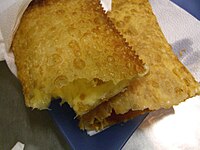Pastel (food)
Pastel is the Spanish and Portuguese word for pastry, a sugary food, and is the name given to different typical dishes of various countries where those languages are spoken.
In Brazil, pastel (plural: pastéis) is a typical street-food Brazilian dish consisting of half-circle or rectangle-shaped thin-crust pies with assorted fillings, that can be savory or sweet, and fried in vegetable oil.
Popular folklore states that Brazilian Pastels originated when Japanese immigrants adapted Chinese fried Spring rolls to sell as snacks at weekly street markets.
Pastéis can also consist of non-sweet fillings, such as ground meat, mozzarella, catupiry, the heart of palm, codfish, cream cheese, chicken, and small shrimp.
In Indonesia, pastel refers to a pie crust made of thin pastry filled with meat (usually chicken) mixed with vegetables (peas, chopped carrots, and diced potatoes), rice vermicelli, and sometimes slices of egg, then deep fried in vegetable oil.
[5] The similar Manadonese version replaces thin flour pie crust with bread and filled with spicy cakalang (skipjack tuna) is called panada.
In Puerto Rico, where the word is generally used in its plural form (pasteles), it is a dish that includes diced pork (or chicken) with olives, raisins, chickpeas, and sweet bell peppers.



